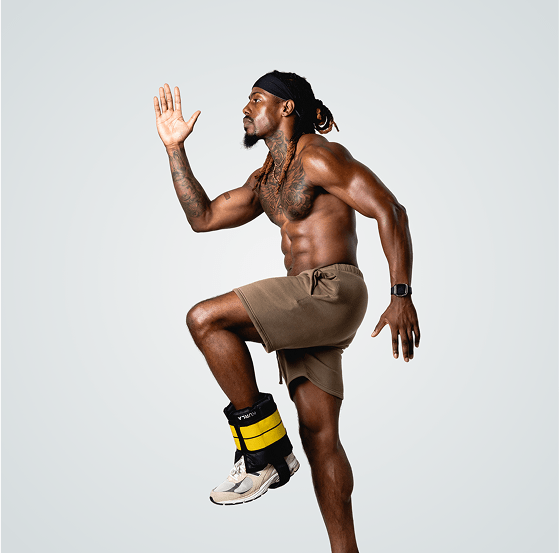Wrist and ankle weights: do they actually work?

Share
Ankle and wrist weights are simple, portable tools that have become increasingly popular in home workouts and rehabilitation routines. From improving cardio to enhancing strength training, they seem to offer a versatile way to increase intensity. But the question remains: do ankle and wrist weights actually deliver measurable fitness benefits?
This blog explores their effectiveness, practical applications, benefits, and the potential risks involved. Whether you're new to fitness or looking to enhance your routine, understanding how these wearable weights work is essential before strapping them on.
What are ankle and wrist weights?
Ankle and wrist weights are a type of wearable resistance that can be strapped around the joints during movement or exercise. Available in a range of weights, they are often used to enhance bodyweight routines, walking, and even basic daily activities.
For example, beginners may opt for something light like a 4 lbs ankle and wrist weight, while more experienced users can try heavier models up to 40 lbs. These weights add resistance to otherwise simple movements, encouraging greater muscle recruitment and increased calorie burn.
How do ankle and wrist weights work?
The primary function of ankle and wrist weights is to add resistance to natural movement. By increasing the demand on your muscles during basic activities, they can help improve overall fitness outcomes.
Wearing these weights can activate specific muscle groups in the lower and upper body. This leads to greater intensity during exercises like walking, step aerobics, or calisthenics. The extra load also helps improve balance, coordination, and joint stability over time, especially when the weights are used consistently and properly.
What does the research say?
Multiple studies support the potential benefits of wearable weights. Research from University Hospitals highlights that walking with wearable weights can lead to improved muscle mass and mobility, particularly among older adults.
Harvard Health emphasizes that while these tools can be beneficial, they come with risks if not used properly. Joint stress, overuse injuries, and fatigue are common problems associated with improper use, especially when weights are too heavy or applied during high-impact activity. The general advice from experts is to begin with lighter weights and gradually build up as your technique and form improve.
Benefits of ankle and wrist weights
Increased muscle activation
Adding resistance to basic movements helps activate small and often neglected muscle groups, especially in the hips, arms, thighs, and shoulders.
Greater calorie expenditure
Using ankle and wrist weights during activities such as walking or cleaning can increase energy usage, resulting in a higher number of calories burned over time.
Enhanced functional strength
Because these weights are typically used during real-world movements, they help develop strength that translates to daily life and sports performance.
Improved posture and stability
Engaging stabilizing muscles through wearable weights improves body awareness and can lead to better posture, especially when the use is paired with correct technique.
Risks and how to avoid them
Despite their advantages, ankle and wrist weights are not without drawbacks. If used incorrectly, they can cause strain or injury. Understanding how to avoid common mistakes is key to safe use.
Poor technique
Using too much weight too soon can disrupt your movement mechanics and put unnecessary stress on joints. Prioritize proper form and gradual progression.
Joint strain
Excessive or prolonged use may lead to joint stress, particularly in the ankles and wrists. Heavier weights should be reserved for short durations or advanced users.
Fatigue and overuse
Wearing the weights for extended periods can result in muscle fatigue or repetitive stress injuries. Breaks and moderation are essential to reduce risk.
To use them safely, begin with lower weights such as a 4 lbs ankle and wrist weight. Limit use to short periods of time, especially in the early stages, and avoid applying them during high-impact or fast-paced workouts like running or plyometrics.
Best times to use ankle and wrist weights
These weights are most effective during controlled, low-impact workouts and daily routines. Here are some ideal ways to incorporate them:
-
Walking: Adding up to 4 lbs on each limb during walking increases resistance without overly compromising joint safety.
-
Bodyweight exercises: Enhance movements like squats, lunges, leg lifts, and arm raises.
-
Rehabilitation: Often prescribed in physical therapy to rebuild strength after injury.
-
Daily activities: Even wearing them during chores can help develop base-level endurance and strength.
For beginners, a good starting option is the 4 lbs ankle and wrist weight, designed to balance resistance and comfort for safe progression.
Who should be cautious?
Not everyone should use ankle and wrist weights without medical advice. Those with joint issues, arthritis, recent injuries, or poor balance may experience complications. Before beginning any new exercise tool, consult with a healthcare provider or physiotherapist.
What to look for when buying wearable weights
Choosing quality weights is important to prevent injury and ensure effectiveness. Look for the following features:
-
Adjustable fit that secures well to the joint without shifting during movement
-
Comfortable and breathable material to reduce irritation
-
Even weight distribution to maintain proper body mechanics
-
A range of weight options to allow for progression
Kurla’s wearable weights meet these standards and are available in sizes from 4 lbs to 40 lbs, allowing users of all fitness levels to train progressively.
Are ankle and wrist weights worth it?
Ankle and wrist weights can be a valuable addition to a well-structured fitness routine when used intentionally. They increase resistance in basic exercises, help strengthen stabilizing muscles, and support calorie-burning efforts in a simple, accessible way.
Their true value comes from thoughtful use. Start light, master your form, and gradually build resistance as your body adapts. When used properly, these tools can provide long-term benefits in strength, posture, and energy levels.
Whether you're aiming to enhance your walking routine or introduce variety to home workouts, wearable weights offer a flexible and effective path forward. For those ready to explore, the 4 lbs ankle and wrist weight is an ideal entry point to begin reaping the rewards safely.




